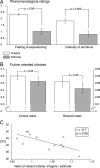A neural mechanism mediating the impact of episodic prospection on farsighted decisions
- PMID: 21543607
- PMCID: PMC6632845
- DOI: 10.1523/JNEUROSCI.6559-10.2011
A neural mechanism mediating the impact of episodic prospection on farsighted decisions
Abstract
Humans can vividly imagine possible future events. This faculty, episodic prospection, allows the simulation of distant outcomes and desires. Here, we provide evidence for the adaptive function of this capacity and elucidate its neuronal basis. Participants either imagined specific events of spending money (e.g., £ 35 in 180 days at a pub), or merely estimated what the money could purchase in the scenario. Imagining the future biased subsequent monetary decisions toward choices associated with a higher long-term pay-off. It thus effectively attenuated temporal discounting, i.e., the propensity to devalue rewards with a delay until delivery. Using functional magnetic resonance imaging, we implicate the medial rostral prefrontal cortex (mrPFC) in this effect. Blood oxygen level-dependent signal in this region predicted future-oriented choices on a trial-by-trial basis. Activation reflected the reward magnitude of imagined episodes, and greater reward sensitivity was related to less discounting. This effect was also associated with increased mrPFC-hippocampal coupling. The data suggest that mrPFC uses information conveyed by the hippocampus to represent the undiscounted utility of envisaged events. The immediate experience of the delayed reward value might then bias toward farsighted decisions.
Figures





References
-
- Abraham A, Schubotz RI, von Cramon DY. Thinking about the future versus the past in personal and non-personal contexts. Brain Res. 2008;1233:106–119. - PubMed
-
- Adams J. The mediating role of time perspective in socio-economic inequalities in smoking and physical activity in older English adults. J Health Psychol. 2009;14:794–799. - PubMed
-
- Amodio DM, Frith CD. Meeting of minds: the medial frontal cortex and social cognition. Nat Rev Neurosci. 2006;7:268–277. - PubMed
-
- Atance CM, O'Neill DK. Episodic future thinking. Trends Cogn Sci. 2001;5:533–539. - PubMed
Publication types
MeSH terms
Grants and funding
LinkOut - more resources
Full Text Sources
Medical
